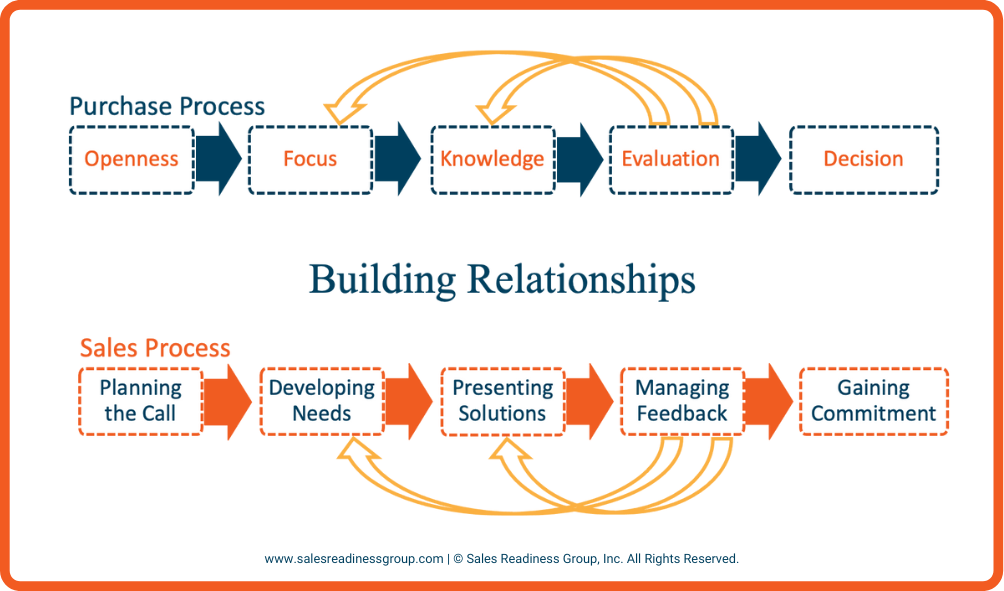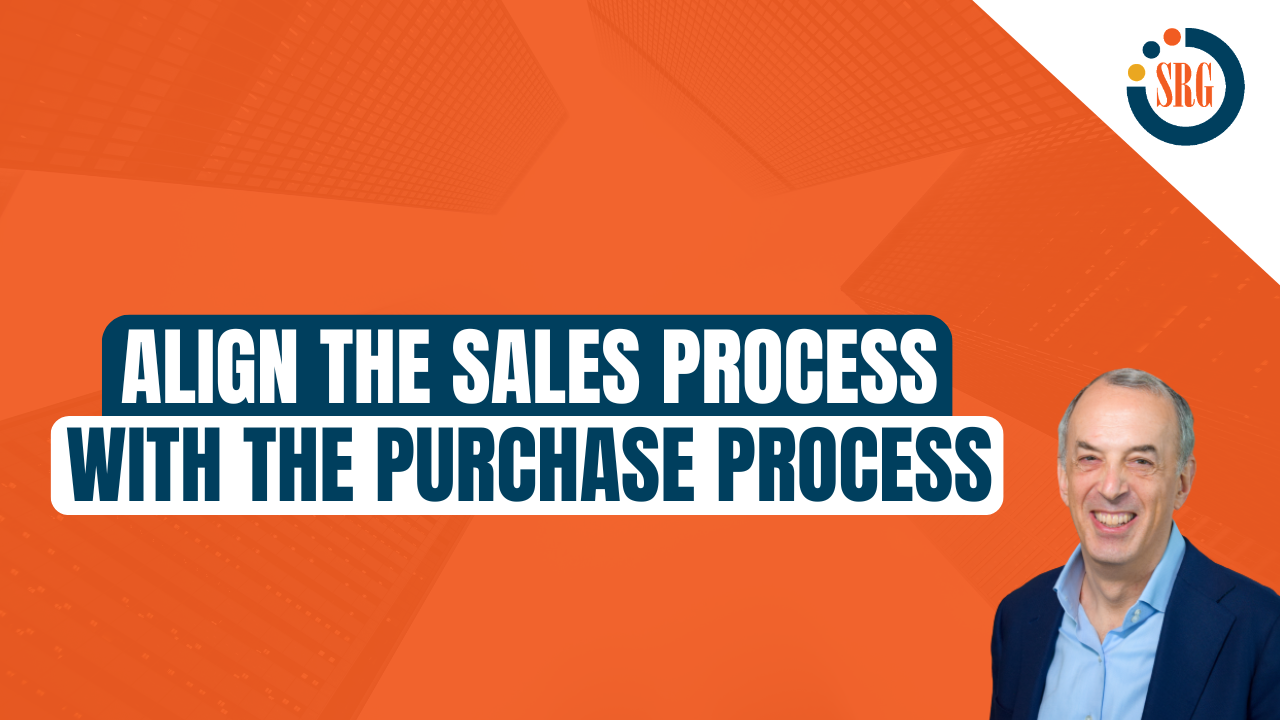Today’s buyers don’t like to be “sold” or pitched. They would rather feel like they are in control of their purchase process. This is why the most successful sales professionals understand this and view their job as helping their customers buy and achieve their goals rather than pushing products. Let’s explore how to use this distinction to build a mindset for successful selling.
The key to this mindset lies in aligning your sales process with the buyer's purchase process. Understanding how your customers make decisions and mapping your sales process accordingly can significantly improve your sales performance. In this article, we will explore the crucial connection between how your customers make purchase decisions versus how you sell and how you can leverage the alignment between these two processes for better sales results.
The Purchase Process
Most sales professionals have a sales process, but few consider their customer’s purchase process. Every buyer goes through a predictable five-stage purchase process before making a purchase. Let's briefly review each of these stages of the Purchase Process using a familiar experience - buying a car:
- Openness: Let's face it – until something makes you open or receptive to a new idea, product, or provider, you will most likely stick with what you have been doing. Using our car example, something happened to your old car: you outgrew it, it quit working, or maybe you wanted a new image to go with your new job. Whatever the reason, something created an openness to consider buying a new car.
- Focus: Once you are open to making a change, the next step is to focus on what is important to you. Do you need better mileage, more room, improved performance, or something else? While you may start with a list of needs, you can also be influenced by co-workers, friends, or even a savvy salesperson.
- Knowledge: Now that you are clear on what you want, your next step is to learn about various car models that would address your needs. Many of us look online, talk to others, and talk with salespeople to see our options. When buying a car, you may research extensively before speaking with a salesperson.
- Evaluation: In the evaluation stage, you compare different options to see how each would address your needs. In the case of a car, you test drive a few different models and evaluate how each one addresses your needs.
- Decision: Finally, you decide to buy a specific car model, not buy, or continue looking.
For relatively simple purchase decisions, a buyer may move through these stages quickly. In complex purchases, however, it is a long process, that may involve multiple decision-makers entering the purchase process at different stages. It is also essential to notice that the process is not linear. A buyer can advance through several stages of the purchase process and then return to a previous step before moving forward.
To effectively guide buyers through their purchase process, aligning their journey with your sales process is essential. By understanding the stages of the buyer's purchase process, you can better position yourself to help them make a buying decision. In the next section, we explore how the common 5-stage sales process corresponds to the buyer's purchase process.
The Sales Process
For each stage of the buyer’s purchase process, there should be a corresponding stage in your sales process. Here is a common sales process:
- Planning the Call: For a successful salesperson, meticulous planning and preparation are crucial before engaging with a potential customer. By understanding the buyer's needs, preferences, and prior interactions, you can tailor your approach and maximize the chances of a successful sale.
- Developing Needs: Identifying your customer's needs holds exceptional importance. Without a comprehensive understanding of what your customer’s problems, initiatives, and challenges, it’s difficult to provide them with a solution that resonates.
- Presenting your Solution: Once you clearly grasp the buyer's needs, you can move forward and present your solution. Your goal is to demonstrate how your product or service can address their specific challenges in a compelling way.
- Managing Feedback: After presenting your solution, it is common to receive feedback from the buyer. This feedback can range from positive responses indicating enthusiasm and eagerness to manage negative feedback in the form of objections or concerns. Effectively managing feedback is crucial as it allows you to either address objections (negative feedback), or expand the sales opportunity (positive feedback).
- Gaining Commitment: The ultimate objective of your sales process is to secure the customer's commitment. By gaining commitment, you solidify the buyer's decision to move forward and ensure a successful sale. This commitment can take various forms, such as a verbal agreement, a signed contract, or an initial purchase.
Aligning Your Sales Process with the Buyer’s Purchase Process

Knowing how buyers make decisions puts you in an advantageous position. It allows you to align your sales process to the buyer's purchase process. This makes selling much more natural and less adversarial as you “guide” your customer through their own purchase process rather than “push” them through your sales process. Moreover, identifying where the buyer is in their purchase process enables you to apply the appropriate selling skill to move their purchase decision forward.
Here’s how you guide the buyer through their Purchase Process:
- When the buyer is in the Openness stage, you should be Planning the Sales Call. If you have done your pre-call research, the buyer will feel you are well-prepared and be more open to share information with you.
- When the buyer is in the Focus stage, you should be Developing his or her Needs. This means asking open-ended questions for sales that help the buyer think through their problem, the business impact of the problem, what an ideal solution looks like, and the impact of their solution.
- When the buyer is in the Knowledge stage, you should be Presenting Solutions. This is the time to explain to the buyer how your proposed solution addresses their needs.
- When the buyer is in the Evaluation stage, you should be Managing Feedback. This is when you should be handling objections in sales.
- Finally, when the buyer is in the Decision stage, you should be Gaining His or Her Commitment. This is where you ask for the sale.
Selling the way your customer buys will also result in fewer stalled deals. Problems often occur when a seller move things along before the buyer is ready. A fundamental mistake many sales reps make is asking for a commitment too early – for example, when the buyer is in the Knowledge or Evaluation stage and not yet ready to make any purchase decision.
Key Takeaways
Aligning your sales process with the buyer's purchase process is essential for achieving better results in sales. By understanding and mapping your strategies to the stages of the purchase process, you can effectively guide buyers and improve your sales performance.
Careful planning and identifying customer needs serve as the foundation for effective selling. To align your sales process, consider tailoring your approach based on the buyer's needs and preferences. Present your solution in a way that addresses their challenges and highlights the unique value your offering brings. Effectively managing feedback and objections allows you to build trust with the buyer. Lastly, gaining commitment solidifies their decision to move forward.
Integrating selling skills with the sales process is crucial for improving sales performance. While top performers often have excellent skills but little regard for process and lower performers adhere to process but lack skills, finding a balance is essential. By integrating skills and processes, sales organizations can enhance their training programs, making it easier for sales managers to reinforce critical skills within the context of the sales process.


